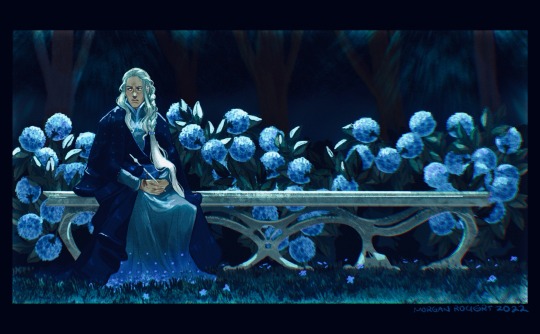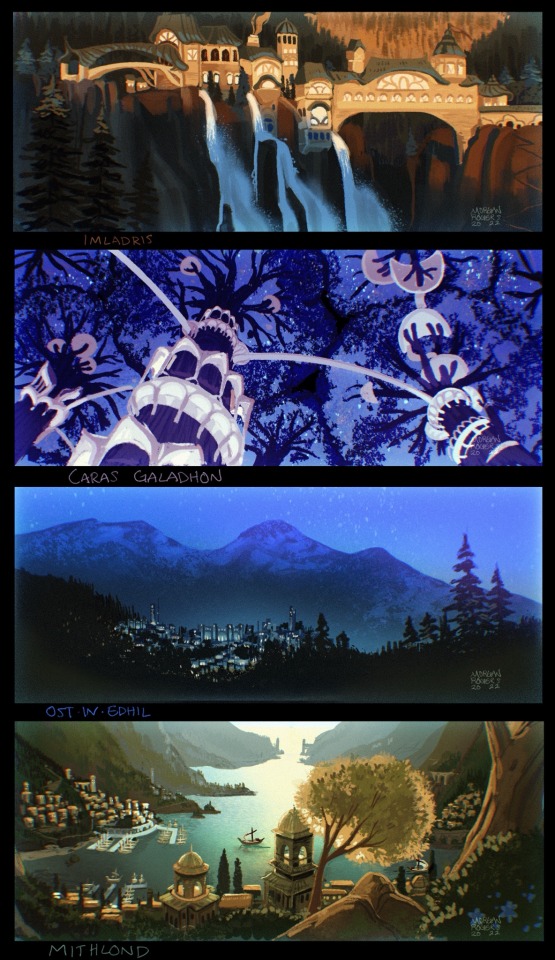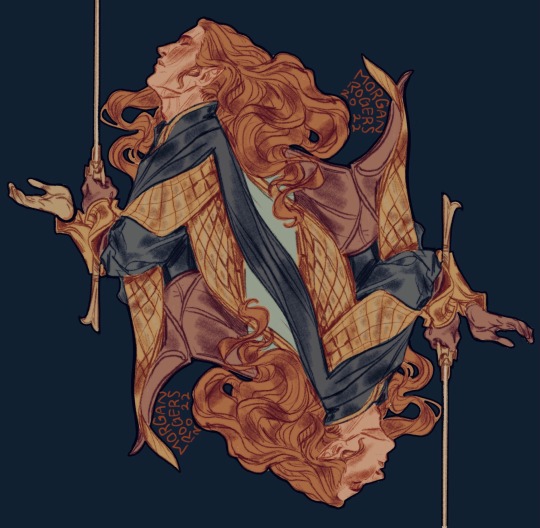#big fan of silver hair daeron????
Text



Daeron pouting in Doriath | Second Age locations | Maedhros
#itty bitty art dump#I don’t really want to post these separately#big fan of silver hair daeron????#daeron#imladris#caras galadhon#ost in edhil#mithlond#the movies have too tight a grip on my location art#maedhros#my art#silmart#art dump#Tolkien#silmarillion
5K notes
·
View notes
Text
The first time I read The Lord of the Rings, I remember thinking 'why is everything so grey?' There was the Grey Company in their grey cloaks, Elrond in his grey mantle and Arwen in her grey dress; grey eyes, silver eyes, symbolism with night and evening and stars. Silver and grey were the colours appearing consistently though the trilogy, most often with the elves and Dúnedain.
So I wondered... Why?
I have said it before and I am saying it again - I am not a big fan of Elrond calling himself a fëanorian, nor am I a fan of him being considered a Noldo.
He is half-elven. It's referred to so often it is impossible to miss. He is called kin of both Elves and Men, and he associates with both.
But if we have to speak of Elrond strictly as of an elf, I do not think Noldor are the way to go.
In The Peoples of Middle-earth, chapter Problem of Ros, we can find this passage:
The names Elros and Elrond that Elwing gave to her sons were held prophetic, as many mother-names among the Eldar. For after the Last Battle and the overthrow of Morgoth, when the Valar gave Elros and Elrond a choice to belong either to the kin of the Eldar or to the king of Men, it was Elros who voyaged over sea to Númenor following the star of Eärendil; whereas Elrond remained among the Elves and carried on the lineage of King Elwë.
Note 19
And also that of Turgon; though he preferred that of Elwë, who was not under the ban that was laid on the Exiles.
It is said Elrond himself preferred his status as the heir of Elwë over Turgon - and while yes, this book isn't exactly full-canon and was posted after Tolkien's death, there are just enough quotes in LotR itself to prove which side of his heritage Elrond preferred.
'... Eärendil was my sire, who was born in Gondolin before its fall; and my mother was Elwing, daughter of Dior, son of Lúthien of Doriath...'
- FotR
Elrond names Eärendil as his father, yes, but that's it - while with Elwing, he names half of his family tree.
More than that, there are the connections of Elrond and his family to the colour gey - the colour of Sindar, Grey-elves, and their king Elu Thingol.
Almost every time a member of the House of Elrond appears, they are wearing grey or are described in relation to the evening, stars, night.
And while stars are associated with all elves, the combination of all those elements is most common with - you guessed it - Sindar.
[of Elrond] His hair was dark as the shadows of twilight, and upon it was set a circlet of silver; his eyes were grey as a clear evening, and in them was a light like the light of stars.
-FotR
[of Arwen] ... and the light of stars was in her bright eyes, grey as a cloudless night; yet queenly she looked, and thought and knowledge were in her glance, as of one who has known many things that the years bring. Above her brow her head was covered with a cap of silver lace netted with small gems, glittering white; but her soft grey raiment had no ornament save a girdle of leaves wrought in silver.
- FotR
[of Elladan and Elrohir] ...two tall men, neither young nor old. So much alike were they, the sons of Elrond, that few could tell them apart; dark-haired, grey-eyed, and their faces elven-fair, clad alike in bright mail beneath cloaks of silver-grey.
- RotK
Elrond wore a mantle of grey and had a star upon his forehead, and a silver was in his hand, and upon his finger was a ring of gold with a great blue stone, Vilya, mightiest of the Three.
- RotK
There are more connections - Elladan and Elrohir bearing a silver banner, the above mentioned Grey Company who are known friends of the House of Elrond, as well as descendants of Númenor, and others.
In Problem of Ros, we also have this bit:
Now Elrond was a word for the firmament, the starry dome as it appeared like a roof to Arda; and it was given by Elwing in memory of the great Hall of the Throne of Elwë in the midst of his stronghold of Menegroth that was called Menelrond, because by the arts and aid of Melian its high arched roof has been adorned with silver and gems set in the order and figures of the stars in the great Dome of Valar in Aman, whence Melian came.
More connection to stars, to Menegroth, to Elwing, to Thingol.
And of course, of Thingol himself:
... Elu Thingol he was called, King Greymantle, in the tongue of his people. They are called the Sindar, Grey-elves, of starlit Beleriand; and although they were Moriquendi, under the lordship of Thingol and the teaching of Melian they became the fairest and the most wise and skillful of all the Elves of Middle-earth.
- The Silmarillion
Greymantle. Grey-elves. Starlit Beleriand. Constant references of Thingol and Sindar being connected to the colour grey, stars. Another interesting thing people seem to forget is that Sindar were wise and skilled and not lesser than Noldor, just different - and even than not much as Noldor and Teleri were told to be alike. Daeron constructed Cirth and was a bard of great renown; Lúthien was... Lúthien, which I don't think needs an elaboration; Mablung and Beleg were respected outside of Doriath; Celeborn, called the Wise; Thranduil, a Sinda who would not fight a war over gold (which is always a smart decision); Elwing who was brave and did the best she could (and before anyone goes at me about Elwing, I recommend this post and reading the notes on it).
Outside of them, it is the House of Elrond and Dúnedain who gets connected to the colour grey the most. I don't think it is a stretch to say that of his elven ancestry, he prefers the heritage from his mother.
In the end I see him as a Sinda-Númenorean who has just enough eldtrichness to show he is a descendant of Melian - and maybe a bit more of it when needed. However, he respects all sides of his heritage - and despite me saying he doesn't see himself as a Noldo, he doesn't have any problem with Noldor, nor does he ignore or dislikes that side of his heritage. He is proud of it and bears many Noldorin traits. He taught his children to be the same. It just isn't the most prominent part of him.
I think his tendency to stand in the background rather than lead himself is also a trait more of Sindar than Noldor, for... Obvious reasons. Most of the Noldor in the First Age fought a battle after a battle, rushed into reckless valiant acts. But if we see Sindar in battle, it's most often because they were attacked first; as a last resort; unexpected kicking ass in Lúthien style; because they see no better option.
And in the end, grey is not exactly a distinctive colour - it tends to fade into the background, but is no less than important.
Just like Elrond. Just like Sindar.
#elrond#thingol#sindar#peredhil#tolkien#ALSO#gil-galad ruled over both noldor and sindar#as did other high kings before him#so elrond being his herald doesn't erase his sindarin part of identity#anyway#if you feel about this differently? cool we all have our opinions#i am screaming about mostky sindarin-númenorean eldritch adventurer elrond who acquired way too many family members and friends and accepts#*mostly#i don't dislike noldorin elrond (nor his kids being noldorin)#i just see them as... well... half-elves leaning towards certain parts of their heritage but respecting all#no i didn't proof-read this and it shows
427 notes
·
View notes
Text
@frootnarcissist replied to your post “Hi, big fan of the blog and seen a lot of your...”
Thank you so much for your detailed response! My bet would be on the Hightowers; the appearance of Alerie and Lynesse, the name Baelor, and perhaps some hint with Lord Leyton’s wife’s name being an anagram of Rhae.
Although I do wonder what, if anything, may be implied by Robert having a “stronger claim” than Jon and Ned, who don’t seem to have any claim whatsoever. The Stark family tree would seem to preclude any descent from Rhae (unless she married a Locke), and it would seem odd not to mention Jon having a Targaryen mother. I suppose Jasper Arryn would be my second guess though.
It’s possible that the current Hightowers are descendants of Rhae, although I don’t personally find any of those points particularly compelling. For one, it’s unclear whether Alerie’s silver hair is due to birth or age: after all, GRRM describes her as “handsome”, a term he often uses to denote women who are older rather than younger (compare Catelyn’s first view of Sybell Spicer as “a handsome older lady”, or the “still handsome though grown somewhat stout” Lady Hewett, or Mariya Darry, who “was still a handsome woman” though “[her] hair was streaked with grey”). Likewise, putting aside Jorah’s insistence that Lynesse looked like Daenerys - which may be less a straightforward truth and more evidence of Jorah’s utterly creepy and possessive sexual obsession with Daenerys herself - his niece Dacey only notes that Lynesse had “hair like spun gold”, which is a specific description GRRM never uses for the Targaryens but several times for the Lannisters (Joffrey, Cersei, and Jaime’s dream of Joanna are all described this way, and Lancel is noted as specifically lacking this color hair compared to Jaime). Nor are Targaryen namesakes exclusive to Targaryen descendants: Daeron Vaith, Aemon Estermont, and the five current Freys with Targaryen names all exist without any specific, known bloodline connection to the Targaryens (and personally, I would much rather have more Targaryen namesakes without specific familial connections). As for Rhea Florent, she is not the only holder of her name; Rhea Royce was the Lady of Runestone in the reign of Viserys I. (Whether you think it coincidental or significant that she was married to a Targaryen is I suppose up to you; I think the former.) But again, with really nothing to go on, there is no way to rule out any family conclusively, any more than there is to suggest one.
As for this quote ...
Robert sat down again. “Damn you, Ned Stark. You and Jon Arryn, I loved you both. What have you done to me? You were the one should have been king, you or Jon.”
“You had the better claim, Your Grace.”
... I take that less as a sign that all three - Jon, Ned, and Robert - had bloodline claims and more a sign that Robert, uniquely among them, had an extra dynastic boost from his blood connection to the Targaryens. Robert’s Rebellion did not start as a war to replace the Targaryens with the Baratheons (even if I tend to think the aim of the southron ambitions bloc was to use such a threat to compel the Targaryen dynasty to honor its wishes); it was only shortly before the Trident that Robert declared his intent to take the throne and the rebel faction’s leaders acclaimed Robert king. I imagine that once the rebel faction realized that it was impossible to work with the Targaryen dynasty any longer - Rhaegar explicitly demonstrating that he condoned his father’s actions - the faction’s leaders had long talks among themselves about who should be acclaimed the new king - but since there had never been a change in dynasty in the history of unified Westeros, the very radicalness of this move potentially opened the door to a completely unrelated individual to take the crown. Ned Stark, of the major commanders of the rebel faction, had been arguably the most personally wronged by the Targaryens - his sister apparently abducted by the crown prince, his father and brother cruelly murdered by the king in a gross mockery of justice, his own head called for by that same monarch - and that emotional background might have lent sympathy to a claim by Ned to take the crown instead. Jon Arryn had been the early leader of the rebel faction, indeed the true instigator of the rebellion - it had been he who had defied the king’s demand for his wards’ heads and called his banners instead - and as the elder statesman of the rebel faction he might have been seen as the most senior and seasoned candidate to take the throne.
However, as Ned pointed out in that quote, he and Jon surely both realized that the best chance the rebel faction had to replace the Targaryens was to go with the individual who represented the nearest relation to the Targaryens, suggesting a continuity of power even as the Targaryen dynasty was overthrown. Robert was not simply the handsome, victorious young battlefield commander who had consistently demonstrated his personal bravery and leadership during the course of the war, but the most senior female-line Targarye relative (excluding, obviously, the lines of Rhaella and Shaera, who had of course married back into the main Targaryen male line). Aerys II’s tyranny and Rhaegar’s support of that tyranny may have made it impossible to tolerate the continued presence of the Targaryens on the Iron Throne, but it had still been the Targaryens who had established the united Westerosi state and had ruled over that state uninterrupted for the better part of 300 years. Robert represented a much more palatable choice for greater Westerosi acceptance in this respect; here was not a dictator with an army claiming the crown by killing everyone else (as the unrelated Ned or Jon might have been seen) but the nearest relation to the Targaryens themselves, claiming a familial right with the Targaryens having lost the throne through their tyranny.
43 notes
·
View notes
Text
Cirsova: Spring 2020 Issue
We are in the middle of a small press fiction golden age – Weirdbook, Tales from the Magician’s Skull, Storyhack, Heroic Fantasy Quarterly come to mind. It reminds me of the old D.I.Y. attitude in punk and alternative music in the late 1970s though the 80s.
It is hard to believe that I reviewed the first issue of Cirsova four years ago. I just read the Spring 2020 issue (Vol 2, No. 3) and have to say it was a pleasant experience.
I have never heard of Michael Reyes before. “Alpdruck!” is an urban fantasy with the character Clock the Chaos Mage. Lots of astral plane fighting in this story. This might appeal to fans of Larry Correia and Jim Butcher.
Cynthia Ward is a writer I recognize. She goes back to Marion Zimmer Bradley’s Sword & Sorceress anthologies. “Pour Down Like Silver” is a femizon story featuring Rhesanna the Swordmaiden. I went into this story with a great deal of skepticism as most femizon stories I have read over the years have been boring. The level of writing is above par and there was an interesting turn of events at the end with the potential for a sequel.
“Lest Darkness Wreck the Stars” by Robert Zoltan is about fourth story of Daeron Vin and Blue that I have read. There is probably the inevitable comparison to the Ur-Fantasy Duo, Fafhrd & the Gray Mouser. Zoltan’s duo find a gem while in an out of the way track. The plot takes a turn into H. P. Lovecraft’s “Colour Out of Space.”
Jim Breyfogle’s “The Golden Pearl” is another of his Mongoose and Meerkat adventures. This one has a tropical setting involving the perils of pearl diving.
D. M. Ritzlin wrote “Slave Girls for Sacrifice” as an homage to cheesy barbarian fantasy movies of the 1980s. He succeeded. Imagine this story with big hair and hair spray, spandex, and a synthesizer soundtrack!
“Praying to Thasaidon” by Tais Teng is set in Clark Ashton Smith’s Zothique. Teng wisely does not attempt to imitate Smith’s writing style. Being set in Zothique, necromancers are involved.
G. Scott Huggin’s “Adeste, Fideles” is a space opera. Earthman find what happened to “the Lost Fleet.”
Adrian Cole was part of the 1970s small press golden age. “Return of the Dark Brotherhood” is set in his Dream Lords universe but after the events in those books. Science fantasy might be the best way to describe this story. It reads as if Ian Fleming had written a science fiction story for 1930s Weird Tales.
“Outside the Outside?” by J. Comer is a review of the erotic RPG of Hugo Nominated author Chuck Tingle. Comer also looks at a fast food themed RPG Feast of Legends.
So, this issue of Cirsova is heavily weighed towards fantasy-heroic fantasy-sword & sorcery with some other fictional sub-genre thrown in.
Layout is double column in a font type and size that is easy on the eye. No wasted space on the pages. Inside art is minimal. Price is $11.99 for paper or $2.00 Kindle . Order from Amazon.
Cirsova: Spring 2020 Issue published first on https://sixchexus.weebly.com/
0 notes